When I make mistakes with needlework or embroidery projects – you know, the kind of mistakes I should have known better and avoided? – I call them Misadventures.
They’re often the result of exploring or experimenting with some technique, some process that has to do with embroidery (because I live, eat, breathe and drink embroidery and it’s the only thing I ever do in my life. Oh wait. No, I do other things, and I have Misadventures in those pursuits, too).
As I explore and experiment, it’s not unusual for something to go amuck.
Maybe this doesn’t ever happen to you. Perhaps you are the one of those amazing people that I look at, with Eyes Wide in Wonder, thinking, She always gets it right. When I grow up, I want to be like her!
But in the meantime, I keep Misadventuring away!
Here is my first laundering misadventure with the piña cloth embroidery pieces that I recently acquired.
When I set out, I even had instructions, so what could possibly go wrong?
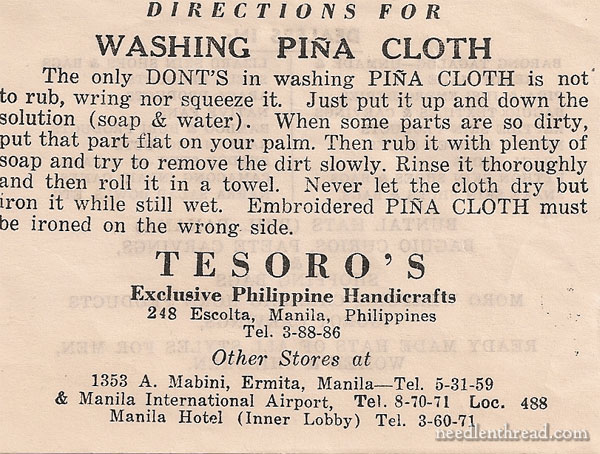
Diane, who has a shop on Etsy called The Windmiller (presently closed while she’s traveling), sold some piña cloth embroidery on Etsy a while ago, and I came across her store while looking for information on the cloth.
Even though her store was closed, I was able to contact her, and we chatted about piña cloth. She sent some photos, including the above information on washing piña cloth embroidery.
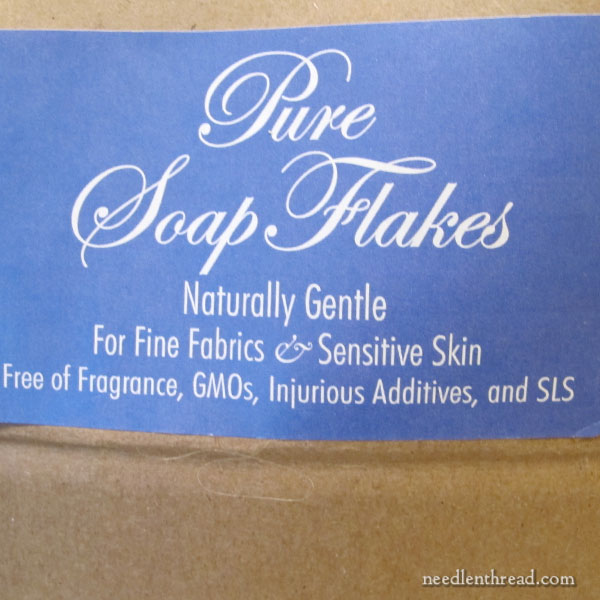
The first thing I did was consider the soap I wanted to use. I decided on Pure Soap Flakes from the aptly-named Pure Soap Flake Company.
I like their soap. It feels good.
But, just so you know, I’m not super-picky about soap. When I have to wash or soak an old embroidered linen, I always start with the most mild approach, but I’ll keep going up on the scale of harshness when it comes to cleaners, if I can’t get the piece to the level of clean that I think I can get it to with a milder approach.
This soap is a nice, mild approach. It’s pure soap, no weird or harsh stuff in it. I suppose one step milder would have been just a good soak in water, or a good soak in water and Orvus. But – this is where I started.
It’s also where I stopped.
And not because I got stellar results – not yet, anyway.
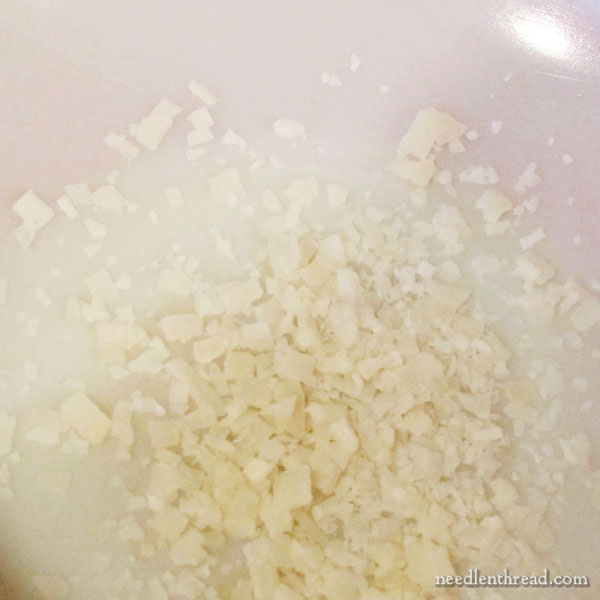
I started by placing about a teaspoon of soap flakes in a bowl and putting the kettle on to boil. My plan was to dissolve the soap flakes in a little boiling water, then add enough cool water to fill the soaking bowl, and then to place the piña cloth into the water, flat, and let it soak.
But as I stood there, looking at the soap flakes in the bowl, I thought a teaspoon really didn’t look like much.
And then I noticed that those little soap flakes look a lot like white chocolate shavings! And a teaspoon of white chocolate shavings is really a negligible amount!
And so I added a little more.
A half a cup looked much better!
(I didn’t taste them, in case you’re wondering.)
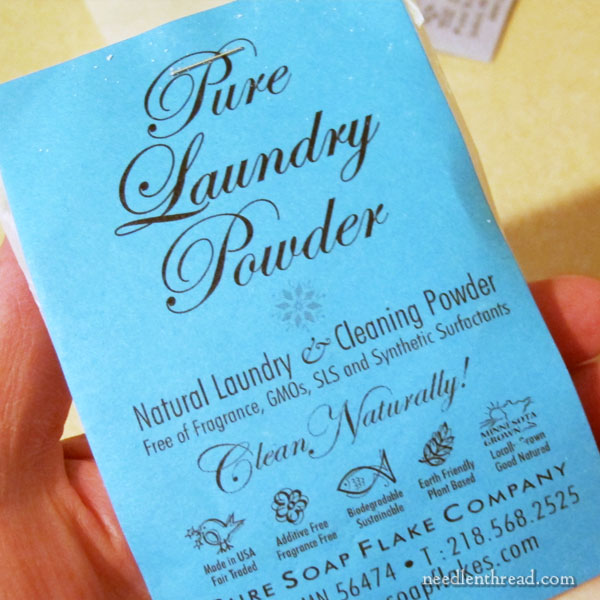
While I was playing with the soap flakes and waiting forever for the kettle, my eyes lighted upon the other product made by the Pure Soap Flake Company, their Pure Laundry Powder.
And I thought, Well, why not? And I sprinkled a little bit – a couple tablespoons – in with the soap flakes.
Then, the kettle boiled. And I added hot water. And I got pretty much all the soap melted, but some of it didn’t seem to want to melt in that little bit of hot water. In fact, the water seemed a bit on the over-soapy, a-little-slimy side. So I added a little more hot water, and kept stirring.
Eventually, it all pretty much dissolved, so I added some cool water so that there was about a quart of water altogether, swished the water up a bit, and then I carefully laid my piña cloth in and left it to soak.
And then I proceeded to forget about it.
And that’s not necessarily a bad thing. Sometimes, soaking old linens stained with age can take a long, long time before any decent results can be seen.
It was a day later when I remembered to check on this piece.
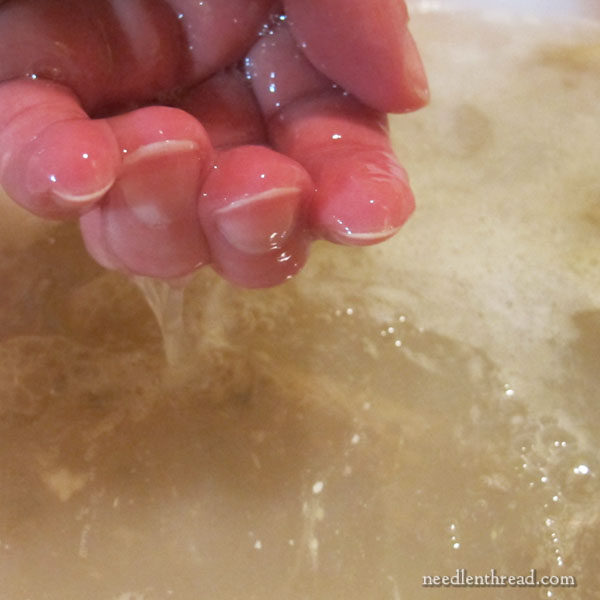
Now, don’t worry. The piece is intact. It’s fine. But it didn’t really clean up at all!
Because, you see, it never really soaked. The water / soap concoction – or should I say, the soap with a little water in it? – set up upon cooling.
When I came back to the cloth, it was encased in a jello mold of murky-colored soap.
At first I thought the pineapple fibers had gone to jelly!
When I touched the surface of the “water,” it resisted – just like jello would. I saw, below the murky surface, my piña perfectly encased.
So I started scooping at the water, and the jello-like consistency relaxed into a liquidy gel.
In the photo above, I’m scooping up very thick gel, which pulled right out of my hand like a heavy, drippy goo. It was wonderful!
I pulled the piña cloth out, and though coated in goo, it was in good shape. I rinsed it. And rinsed it. And rinsed it. And rinsed it some more.
The “soaking” hadn’t really done anything to it. I suspect that, in the jellied state of the soap and water, not much soaking went on.
The moral of the story: Soap flakes are not white chocolate. More is not better.
The piña cloth is soaking in a different solution now.
Some More Piña Cloth Embroidery
Here are some photos of the embroidered piña cloth tablecloth that Diane (who sent me the cleaning instructions) sold on Etsy. She graciously allowed me to share them with you.
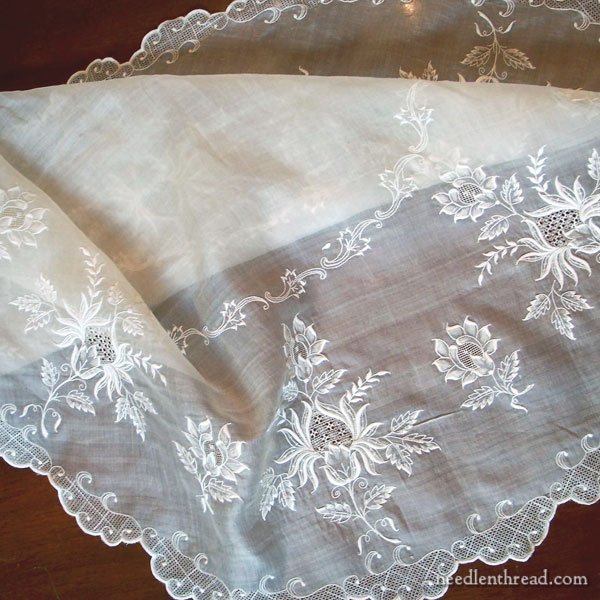
I love the motifs on this piece! Whoever bought it found a real treasure – it’s gorgeous!
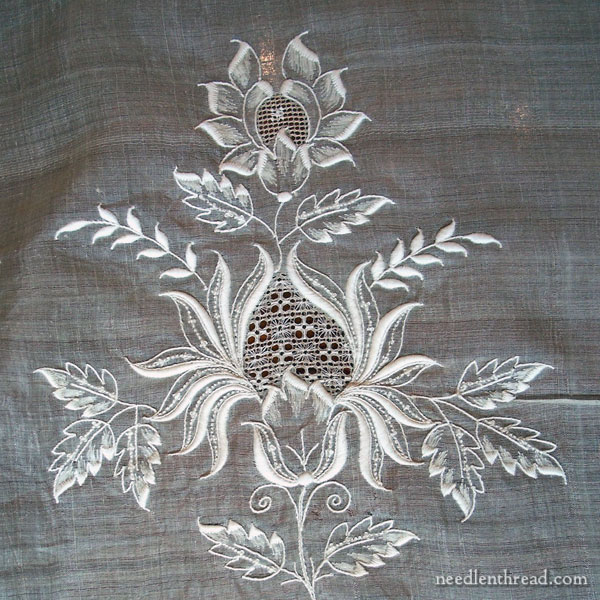
Here’s the repeated motif a little closer…
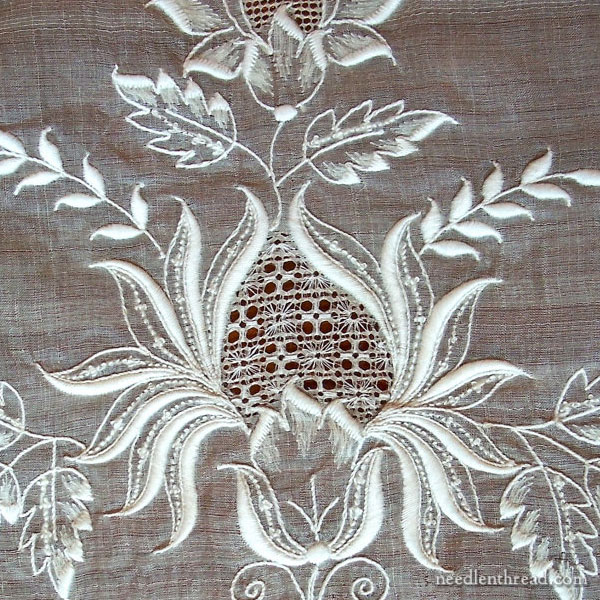
…and yet a little closer. That drawn thread area in the center must be so very fine and tiny.
Well, my friends, I will let you know how my soaking works out.
In the meantime, tomorrow, we’re having a give-away. See you then!
And of course, I’m always open to ideas, suggestions, questions, and commentary, if you want to chime in below!







You started my day with a bang and a bubble. LOL Soap jello – who would have ever thought of that. I’m sorry your soaking technique didn’t work but I’m sure you made a lot of people happy today. I wish my “misadventures” were as much fun.
I generally use Ivory grated from the bar since I can’t find Ivory Flakes anymore. I make a paste, as you did with the Pure Soap product and then dilute it to a solution. Then, I used to add a tablespoon full of Snowy Bleach, which isn’t made anymore, so I have substituted a tablespoon of either powdered Biz or powdered Oxyclean, both oxygen bleaches. I let the piece sit in the mixture for up to three weeks, depending on how stained it is. Every day or two I rinse with clear water, change the soaking solution and repeat. I generally get really good results. The original recipe came from the Valentine Museum in Richmond, VA.
Sounds like a good plan, Patricia! This is essentially what I’m doing, only I’m using Borax as the additional whitener. If I don’t get good results, I’ll try Biz. One thing about Oxyclean is it’s not good for silk, and I believe the little drawn thread elements are done with a silk thread. Well, we’ll see how it goes!
Ohhhhhh, sooooo pretty! I am always drawn to white on white work. Each time you share one it rings true to my heart. I wonder why that is? Maybe I was a pina purveyor in a past life? LOL
Thank you sooo much for sharing, truly it’s one of a kind and a rare find. If I can’t own it I love enjoying it visually.
Happy Hump Day to you!
You have been blessed with a wonderful gift of expressing yourself in writing! I love reading your posts, they always make me smile. We view things in much the same way. I don’t comment on every post but be assured they all bring me much enjoyment. Thank you for sharing your talents with us.
Thanks, Julia! 🙂
Dear Mary
Oh dear the times I have had the same misadventure and like you nothing drastic happens, but lessons are learnt I’m glad the pina cloth wasn’t ruined and are not nicely soaking in other powders. The photos of the pina embroidery pieces are lovely, it must be difficult embroidering on such sheer fabric but beautiful motifs. Thanks for sharing your misadventure and I’m glad I’m not the only one who goes a misadventuring into the unknown.
Regards Anita Simmance
Oh my goodness – what a very odd reaction; kitchen chemistry can be very exciting… But after the shock wears off these Little Mishaps can be quite educational in the figuring out of what works and what doesn’t. I speak from bitter experience but will spare you the tales of biological disaster from my own kitchen!
Mary, you’re just not busy enough, you need to make soap too… ;))
Hi Mary,
I can relate to forgetting the cloth while soaking. That’s why I always set a timer for myself.
Thanks for the giggle- you have a way with words.Beautiful work on the tablecloth .I love the elegance of it.
We have used a product called Vintage Soak for years with no adverse effects. Not on pina cloth as I have never seen it until now. It has removed menstral stains 70 years old with no harm to the fibers we have used it on silks and embroidered church linens with out fading the colors. If you like I can mail you a sample. I do stock it in our shop. I understand it is mined in Italy and been in use there for centuries.
beautiful
Hi Mary,
Carefully using my Ivory Soap Flakes. Haven’t seen them on this island in a long while. They are my tried and true.
Soap used to be made from wood ashes, so jello soap may not be so bad. lol
ji
One thing I learned about cleaning fragile textiles was the use of a sponge. If the piece is flat that you are trying to clean, you can put your cleaning/soaking solution in a jelly-roll pan (high topped cookie sheet) or something like that. In which your piece can lay flat. On particularly tough spots (or dirty spots), place a sponge over that spot and push it up and down, drawing the cleaning solution in and out of it — agitating without moving the cloth.
So curious about this discussion. My Father was stationed at the embassy in Manila when both my sister and I were born. My sister has a beautiful christening dress made of piña cloth that was given to her by her godmother.
My Mother was given one of the native dresses made of piña. We gave it to the Costume Collection at Va Tech as much to be an example of the fiber. We had no other idea what to do with it. We still have fabric that is woven to be made into a man’s shirt. The embroidery is placed on the sleeves and front. If anyone is interested, let me know.
Eventually, the piña cloth was soaked in what solution?
Thank you for the info!
I had a good laugh over your Pina cloth misadventures. Me thinks you are an overdoer!
I wanted to send you my way of storing needles but couldn’t find my big book. We moved last year to Montana (our kids came and packed us up and moved us to live with them) and since I was recovering from what my doctor called cardiac distress which caused a huge weakness, a lot of unpacking is still to be done. Anyway I made a large book and small book for my needles. The large is for all my collection and the small for only Brazilain Embroidery. I used a 9×7 inch notebook for the large and I am still finding needles to include. They are getting rather crowded so may have to go larger yet!
Thank heavens someone is willing to take the bullet so that the rest of us won’t have to! That was a pretty good chuckle. I wonder what would have happened if you had simply added more hot water. Probably just even more goo. Just think of all the other laundry that could have been done. Well at least your plumbing got cleaned out. I’m glad you’re the adventuring sort that is willing to share.
Hello Mary,
Have you ever tried Perk from Twin Pines labs. I find it works miracles and was formulated so as not to adversely affect the fabric finish.
Regards,
Tim
When we lived in the Philippines my husband had pina embroidered barongs made for himself and my boys. Philippine formal dress = to our formal tuxedo. We actually washed them with Tide and pre-treated Spray and Wash just like any other piece of laundry, but used room temp/cold water and then they were left to hang dry until just damp and ironed completely dry. I will check with my Philippina friends to see how they wash their items, but I’m sure they are not dry-cleaned and most don’t use any fancy hard to find soaps.
I could see there was trouble coming … too much soap … but soap jello, now that was unexpected!
The tablecloth is beautiful!
This post is just wonderful! The fact that you can laugh at yourself is such a human thing, and, in my opinion, makes you approachable. Thank you so much for all you provide to this community!!
That is hilarious! And informative, too. Thanks!
Mary I forgot to ask but would you take a picture of this fabric as it’s draped over your hand? I want to get a sense of the feel and see how sheer it is. Also, does it come in various weights like linen?
Too Funny…I made a similar mistake when making my own liquid laundry soap. Less is more, much more in this case. Would bluing work? Good luck.
Talk about mistakes! I got so excited I ordered the book from South Africa yesterday and some pieces but not the whole kit. Today I found the book, which I ordered last year. Anyone who wants to buy a book locally can get it from me! I don’t need two! I can’t afford two! Postage from me is definitely cheaper! Please let me know if anyone’s interested…
My husband grew up in the Philippines from age 6 to 11. He recalls wearing pina barong shirts on special occasions. They were exquisitely embroidered, and were cared for by a native maid. Unfortunately, I do not know the process, but I will ask my mother-in-law, who might be able to provide that information.
Hi! thanks for including the cleaning instructions of the pina cloth from Tesoros. Feel free to check the website http://www.tesoros.ph for beautifully handcrafted clothing, shawls and tablecloths.
No, I didn’t laugh (much). I just know that I would have done the exact same thing (only the ‘forgetting about it’ part would likely have extended into several days, or possibly weeks). Thank you for sharing the bad with the good!
Mary
I have been using a business in the Philippines who I have found very helpful and reliable.
The fabric is excellent,smooth and even. Woven by a traditional weaver.
I get it for a few of my group who like sewing on it.
Regards
MM
Here are some Pina prices for you:
Also for some of the other varieties.
1. Pure Pina 4 yards is US$120 Pineapple fibre only
2. Pina Silk 4 yards is US$70 (combination Silk and Pina)
3. Pina Cocoon 3 yards – US$60 (combination Silk and Pina)
4. Pina Jusi 2 3/4 yards is US$35 (Jusi Silk resembling Pina)
BarongWarehouse.com
info@barongwarehouse.com
Facebook, Instagram, Twitter:
BarongWarehouse
Viber/Text/Call: +639189851205
Google Hangouts: Barong Tagalog
Thanks for referring us! Yes, if any of you have any Pina cloth needs, drop us an e-mail and we’d be happy to assist. Great article!
Me interesan muchisimo la tematica en tu pagina Tan solo queria desearte suerte y darte la
enhorabuena Bye
Mary
I don’t use soap as even the gentilest of soap has lye in it. Which is a caustic.
I use pineapple juice and a couple of 2 drops or pears hand wash. If I wash a Pina Shirt I put the juisce in a flat dish or tub and drop the soap on the collar or cuff. And I use a finger to press the detergent into the soilded part. I may have to press several times until I can see a difference.
This cloth is really quite forgiving but I never wring, squeeze or shake. Best Lay flat on a large sheet or towel and with flat of hand. Dry in shade, iron when still slightly damp and on the wrong side.with a piece of cloth between iron and fabric.
Using white vinegar to whiten is good but I am late for meeting so will drop a line later.